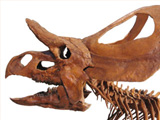|
|
TODAY.AZ / Weird / Interesting
Last dinosaur before mass extinction discovered
14 July 2011 [13:53] - TODAY.AZ
 A team of scientists has discovered the youngest dinosaur preserved in the fossil record before the catastrophic meteor impact 65 million years ago. The finding indicates that dinosaurs did not go extinct prior to the impact and provides further evidence as to whether the impact was in fact the cause of their extinction.
A team of scientists has discovered the youngest dinosaur preserved in the fossil record before the catastrophic meteor impact 65 million years ago. The finding indicates that dinosaurs did not go extinct prior to the impact and provides further evidence as to whether the impact was in fact the cause of their extinction.Researchers from Yale University discovered the fossilized horn of a ceratopsian -- likely a Triceratops, which are common to the area -- in the Hell Creek formation in Montana last year. They found the fossil buried just five inches below the K-T boundary, the geological layer that marks the transition from the Cretaceous period to the Tertiary period at the time of the mass extinction that took place 65 million years ago.
Since the impact hypothesis for the demise of the dinosaurs was first proposed more than 30 years ago, many scientists have come to believe the meteor caused the mass extinction and wiped out the dinosaurs, but a sticking point has been an apparent lack of fossils buried within the 10 feet of rock below the K-T boundary. The seeming anomaly has come to be known as the "three-meter gap." Until now, this gap has caused some paleontologists to question whether the non-avian dinosaurs of the era -- which included Tyrannosaurus rex, Triceratops, Torosaurus and the duckbilled dinosaurs -- gradually went extinct sometime before the meteor struck. (Avian dinosaurs survived the impact, and eventually gave rise to modern-day birds.)
"This discovery suggests the three-meter gap doesn't exist," said Yale graduate student Tyler Lyson, director of the Marmarth Research Foundation and lead author of the study, published online July 12 in the journal Biology Letters. "The fact that this specimen was so close to the boundary indicates that at least some dinosaurs were doing fine right up until the impact."
While the team can't determine the exact age of the dinosaur, Lyson said it likely lived tens of thousands to just a few thousand years before the impact. "This discovery provides some evidence that dinosaurs didn't slowly die out before the meteor struck," he said.
Eric Sargis, curator of vertebrate paleontology at the Yale Peabody Museum of Natural History, and graduate student Stephen Chester discovered the ceratopsian last year while searching for fossilized mammals that evolved after the meteor impact. At first, Lyson said, the team thought it was buried within about three feet of the K-T boundary, but were surprised to learn just how close to the boundary -- and hence, how close in time to the impact -- it was. They sent soil samples to a laboratory to determine the exact location of the boundary, which is marked by the relative abundance of certain types of fossilized pollen and other geological indicators but is difficult to determine visually while in the field.
Because the dinosaur was buried in a mudstone floodplain, the team knew it hadn't been re-deposited from older sediments, which can sometimes happen when fossils are found in riverbeds that may have eroded and re-distributed material over time.
The team is now examining other fossil specimens that appear to be buried close to the K-T boundary and expect to find more, Lyson said. He suspects that other fossils discovered in the past may have been closer to the boundary than originally thought and that the so-called three-meter gap never existed.
"We should be able to verify that using the more sophisticated soil analysis technique rather than estimating the boundary's location based solely on a visual examination of the rock formations while in the field, which is what has typically been done in the past," Lyson said.
Other authors of the paper include Eric Sargis and Stephen Chester (Yale University); Antoine Bercovici (China University of Geosciences); Dean Pearson (Pioneer Trails Regional Museum) and Walter Joyce (University of Tübingen).
/Science Daily/
URL: http://www.today.az/news/interesting/90379.html
 Print version
Print version
Views: 1708
Connect with us. Get latest news and updates.
See Also
- 06 December 2024 [22:20]
Are scented candles harmful to health? - 23 November 2024 [14:11]
Magnitude 4.5 earthquake hits Azerbaijan's Lachin - 20 November 2024 [23:30]
Launch vehicle with prototype of Starship made its sixth test flight - 27 October 2024 [09:00]
Fuel prices expected to rise in Sweden - 24 October 2024 [19:14]
Turkiye strikes terror targets in Iraq and Syria - 23 October 2024 [23:46]
Kazakhstan supplied almost entire volume of oil planned for 2024 to Germany in 9 months - 23 October 2024 [22:17]
Taiwan reported passage of Chinese Navy aircraft carrier near island - 23 October 2024 [21:50]
Russia remains largest oil supplier to India - 16 October 2024 [17:54]
Gamesummit co-founder shares insights on future of gaming industry in Azerbaijan [EXCLUSIVE] - 12 October 2024 [18:27]
TikTok cuts jobs, turns to AI for content moderation
Most Popular
 Pashinyan plants a pig for the Armenians
Pashinyan plants a pig for the Armenians
 Changing global geopolitics & implications for Pakistan
Changing global geopolitics & implications for Pakistan
 U.S. finalizes US$4.7 bln in CHIPS Act subsidy to Samsung Electronics
U.S. finalizes US$4.7 bln in CHIPS Act subsidy to Samsung Electronics
 Turkish FM meets Syrian leader in post-Assad era
Turkish FM meets Syrian leader in post-Assad era
 Gloveman: Macron and his one-time premieres
Gloveman: Macron and his one-time premieres
 New Zealand rejects plan to introduce its own passports for residents of Cook Islands
New Zealand rejects plan to introduce its own passports for residents of Cook Islands
 Azerbaijani ambassador discusses climate cooperation with Iranian officials
Azerbaijani ambassador discusses climate cooperation with Iranian officials
